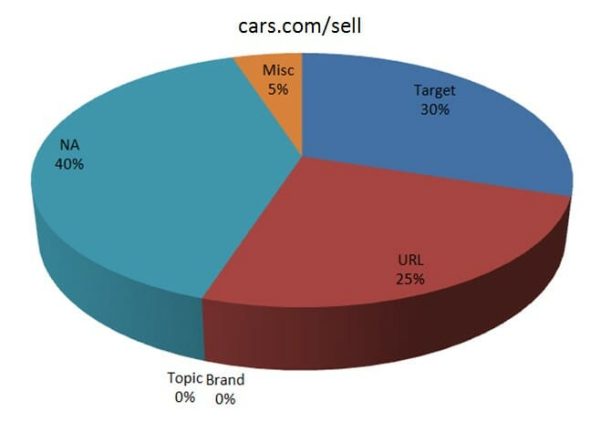Undoubtedly, the most crucial expertise in offsite SEO lies in mastering the art of anchor text selection.
Achieving the ideal anchor text distribution can propel you to the top of search engine results pages (SERPs) with fewer links compared to your competitors. Conversely, poor anchor text selection could result in a dreaded Penguin penalty.
As an SEO expert, the most frequent question I receive from clients is: “Which anchor text should I use?” While I’d be thrilled to provide a straightforward answer, the truth is that it requires more than just a five-minute explanation.

Choosing the perfect anchor text involves thorough analysis and practice. However, there is a systematic and consistent approach you can adopt to optimize your site effectively. It’s crucial to develop this skill independently, rather than relying on others, to truly excel in SEO.
Once you’ve mastered this technique, it’s akin to advancing to the next echelon of SEO expertise.
In this guide, you will discover the method to determine the optimal anchor text ratio tailored to your specific website, 13 innovative anchor text selection strategies to outperform your competitors, and techniques for maintaining a well-balanced internal anchor text ratio.
For those that prefer video consumption, here you go:
What is Anchor Text?
Anchor text is the clickable text in a link.
In HTML it looks like this:
<a href=”https://diggitymarketing.com”>Awesome SEO Blog</a>
And on your webpage, it comes out like this: Awesome SEO Blog.
In this example “Awesome SEO Blog” is considered to be the anchor text.
Why Care About It?
You should care about it because anchor text is one of the indicators that Google uses to determine relevance.
For example, if a website is constantly getting quality links with the anchor text “ collar”, Google is eventually going to determine that your site is about collars.
Simple stuff.
Back in the day, to get websites ranking, all you’d need to do to rank is send enough links with the anchor text exactly matching the keyword you want to rank for.
Ah… the good old days.
And then Penguin Came
The Penguin algorithm (started April 24, 2012) targets backlink manipulation.
It looks at the quality of the links your site is getting and, you guessed it, the anchor text pointing to your site.
If the anchor text distribution doesn’t look realistic, then you get penalized.
Sending anchor text with your keywords in it gets the ranking needle moving, but overdo it to the point that it doesn’t look realistic, and you’re going to be headed south very soon.
Now the question is, what is realistic for Google?
External Anchor Text Optimization
Determining Your Niche-Specific Target Anchor Text
The first step in anchor text selection is to figure out what is the ideal target anchor text distribution for your niche.
Here’s how I do it, broken down to its basics:
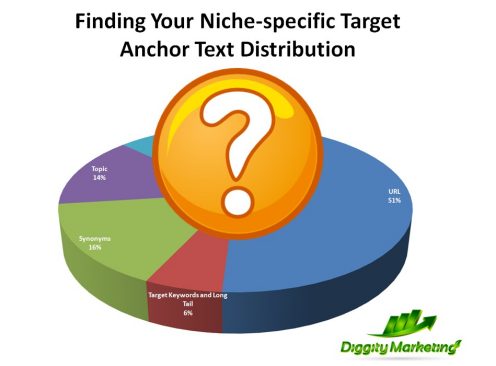
Analyze the Competition
Many SEO’s often talk about needing a “natural” anchor text distribution. When they describe it, it typically looks something like this:
- 50% Brand/URL anchors
- For example, a branded anchor for golfgenius.com would be “Golf Genius”. Branded anchors only apply to non-EMD/PMD sites.
- URL anchors are variations of the ***** URL: golfgenius.com, http://golfgenius.com, www.golfgenius.com, etc
- 25% topic anchors
- Example: “sports equipment” would be a topic anchor for the keyword “best titanium driver”
- 10% target keyword and longtail anchors
- Examples: best titanium driver, what is the top titanium driver, buy titanium driver online
- I define an anchor in this category if it has a single word of a keyword phrase you want to rank for (excluding stop words)
- 15% miscellaneous anchors
- click here, read more, go to website, etc.
We could break this down even further into categories like “Brand + target” (e.g: Golf Genius’ review of titanium drivers), but for the purposes of this exercise, its overkill. We’re looking for guidance, not supreme accuracy.
While many people stick to this idea that you need this perfect, “natural” ratio of various types of anchors, this simply isn’t the case.
Protip: Whenever you do a search for a specific keyword, Google shows you exactly what they like to see in the SERPs.
You’ll learn more about this soon…
Do a search for your target keyword and toss the results into a backlink checker like Ahrefs.
Here, and only here, is where you’ll find the anchor text distribution Google is looking for.
Often this looks nothing like the cookie-cutter anchor text distribution that is supposedly “natural”.
Case in point – Keyword: “sell my car online”
Your anchor text plan often isn’t what you initially expect. I’ve been in niches where I had to consecutively hit the site with target anchors for a month straight until I was able to break into page 1. It’ sounds like anchor text SEO in 2005, but sometimes that’s what the niche is asking for.
Here’s an anchor text distribution that is currently going to the URL of one of my sites ranking #1 for a high-stakes affiliate keyword (It’s been ranked #1 since mid-2018).
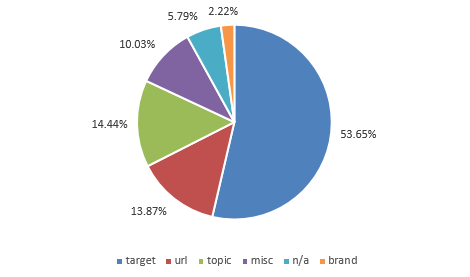
Find the Average Anchor Text Distribution of the Top 5 Rankers
To figure out the target distribution of anchors for my particular niche, I rely on Ahrefs and Excel (alternatively SEO Jet and Linkio supposedly do this).
Step 1) Download the Ahrefs Anchor Text data for the site in position #1
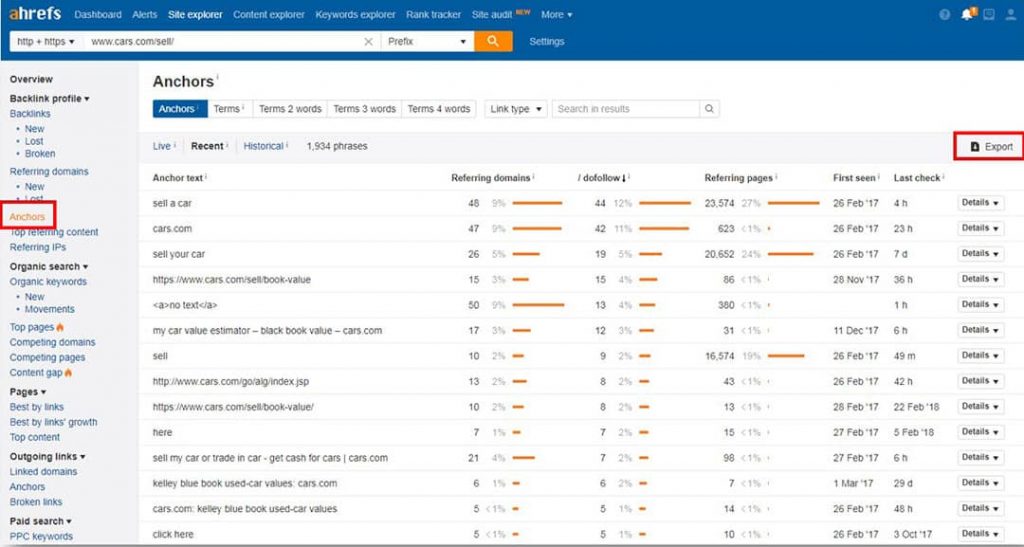
Step 2) Categorize anchors by type
I use the “Referring Domains” column so I don’t double-count anchors sent from the same domain, possibly from a site-wide link.

Step 3) Find the anchor text distribution for this URL by creating a pie chart.
Step 4) Repeat for Sites in Positions #2-5
Step 5) Your Niche-specific Target Anchor Text Distribution = The Average of the Top 5 Sites

Step 6) Record and Implement
Now that you know the anchor text ratio that Google is looking for, it’s time to begin your link building campaign whose anchors will mimic this distribution.
I first start by recording the target distribution down in a Backlink Management Template.
Once you know “where you want to be” you can start incrementally sending links until you get there.
Frequently Asked Questions
Q: This is great. Do I now send these links and anchors across my whole site, such that the overall domain itself gets this distribution?
A: No. Anchor distribution ratios are determined on a per-page basis. Any anchors you send to an inner page, do not affect the ratios on the homepage for example.
Q: My page ranks for many keywords. Which one should I use for my search to pull up the competition?
A: Use the main keyword you’d like to rank for. For affiliates, this is probably “best _____”. For local seo solutions, its probably “<city> + <industry>”.
Q: I believe my competitors are hiding their PBN backlinks. What should I do?
A: First, check to see if they blocked some of the less popular crawlers like Open Link Profiler. If they didn’t block it, great.
If you still can’t find their PBNs, skip over this competitor.
Remember, we’re looking for guidance, not accuracy.
Q: One of my competitors is an authority site that ranks with only 2 backlinks. Should I add it to the analysis?
A: Skip over it as well. It’s an anomaly and will distort your result.
Q: What if one of my competitors disavowed a bunch of their links?
A: You’re getting the theme now. When in doubt, skip over the competitor.
Mastering Anchor Text Selection
At any given time, I’m conducting at least 6 single variable SEO tests. In the last few years, I’ve completed over 200. A huge chunk of them have been related to anchor text.
Get a pen and paper handy because I’m about to reveal 13 anchor text selection tricks that will allow you to blow past your competition’s amateur SEO efforts.
13 Pro-level Anchor Text Selection Tricks
1. Never use the same target anchor text more than once

Whenever I make any SEO decision, I ask myself the question: “Does what I’m about to do look natural?” Anchor text selection is no different.
Back in the earlier days of SEO when you could pretty much get away with anything, people that wanted to rank for “ training” would simply send all their anchors as “ training”.
Clearly, this doesn’t work anymore but I still see it quite often. Money sites will have a balanced anchor text distribution (50% brand and URL, 10% misc, etc), but all 20 of their target anchors will be the same ( training, training, training, …)
What are the **** of this happening naturally? The probability of 20 independent websites all linking to another website using the exact same target anchor text is pretty slim. If you have 500 backlinks it might move into the realm of “remotely possible”.
Instead, never use the same target anchor more than once and mix up your keywords by throwing in filler words. Not only does it look more natural, but it actually gets a better result with fewer links.
So in a nutshell, don’t repeat anchors, except in some cases like…
2. Utilize Your SEO Title Tag as an anchor
Your SEO title tag is something you fill out with your typical SEO management plugins: Yoast, All-in-One, Project Supremacy, etc.

It essentially determines how your page’s title is displayed in the SERP result listing.

Statistically speaking, this anchor text naturally occurs quite frequently. In fact, forums (for example), will even re-write your anchor text and default to the title tag when you link to an external site.
Just check out how often various sites have repeated title tags as anchors on some of my articles.
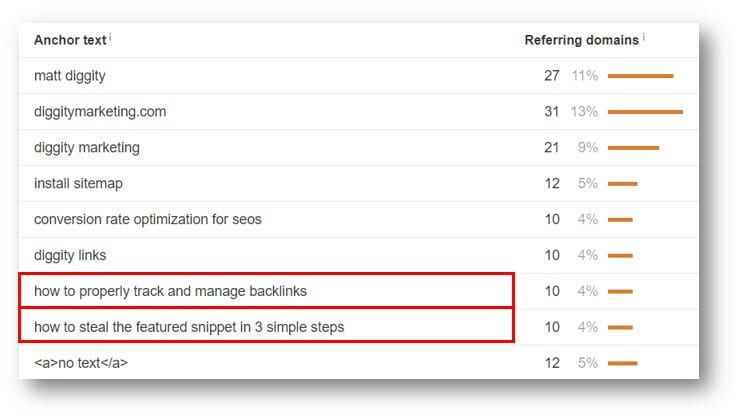
The great thing about the using the title tag as an anchor is that if you’re optimizing it correctly, it should be full of keywords. So when you reference it, these keywords get a lot of **** and you can get away with it because statistically its a common anchor.
To learn more about how to optimize your title tags, check this out:
3. The Anchor Should Suit the Link Type
Links can come from multiple categories of sources. Just to name a few:
- Blog articles
- Link lists
- Sidebars
- Forums
- Comments
- etc
Again, statistically speaking, certain anchor types are used more often with various link types.
This usually results in a target anchor text. Scroll up to the first link I created in this article for an example.
On the other hand, when people create a list of links, they tend to either use branded or URL anchors.
For example: Here’s a list of my top 3 favorite SEO tools…
And how about sidebar links? 90% of the time people use images for their sidebar links. And what do “normal people” use as their alt tags (image equivalent of an anchor text)?
Usually, they simply describe what the picture is about…. or here’s the kicker… nothing at all.
Many people don’t know what an alt tag is, so they’re left blank. And that’s how you end up with so many empty anchor texts.
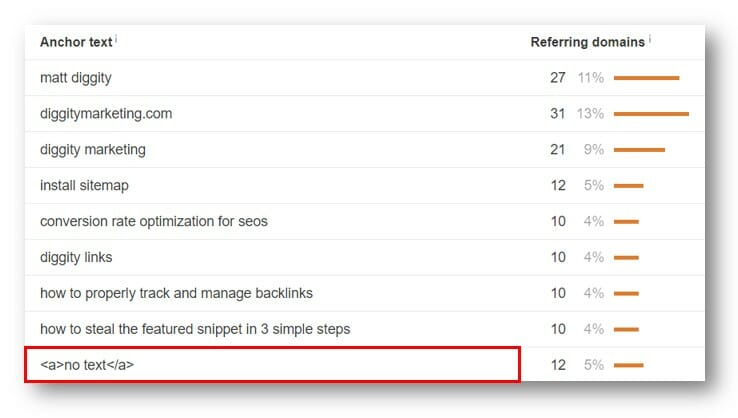
So use sidebar image alt tags for some general misc pillow link anchors (e.g.: product in blue packaging) or empty anchors.
In forums, people usually link with the URL or the SEO title tag as you learned before.
Lastly, with blog comments, people mostly use a name as an anchor.
4. Use the persona’s name as an anchor
If your website has any type of persona associated with it, sprinkle in some links with that persona’s name as the anchor.
It occurs naturally and frequently. In fact, “matt diggity” is the most common anchor that I have going to my site.
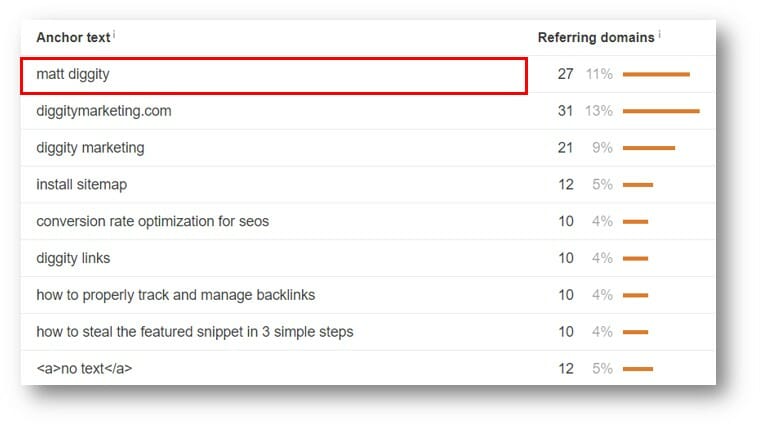
These days, as I teach in The Affiliate Lab, I create a persona for each and every one of my affiliate sites.
This persona remains consistent across my hosting records, whois, social profiles and about page. It adds another level of “completeness” to the site.
5. When stuck, break up your keyword phrase
Let’s say your keyword is “plumber new york”. If you’re stuck in the rankings and simply aren’t getting any movement no matter how many links you throw at it, try sending just the word “plumber” or just the word “New York”.
I’m not exactly sure why, but it works. Likely because it just looks more natural. It’s completely possible that a New York newspaper writes an article about home maintenance companies in the area. They wouldn’t be making anchors like “New York plumber” because it’s already implied, being that they’re a New York newspaper.
I can’t count how many times this technique has gotten me out of a rut. Give it a shot.
6. Brand + target anchors
Another anchor type that appears frequently (especially in physical product niches where Amazon is present) is a combination of target keywords with Brand or URL.
Here’s an example in the essential oil diffuser niche. Notice how often Amazon and target anchors come in pairs:
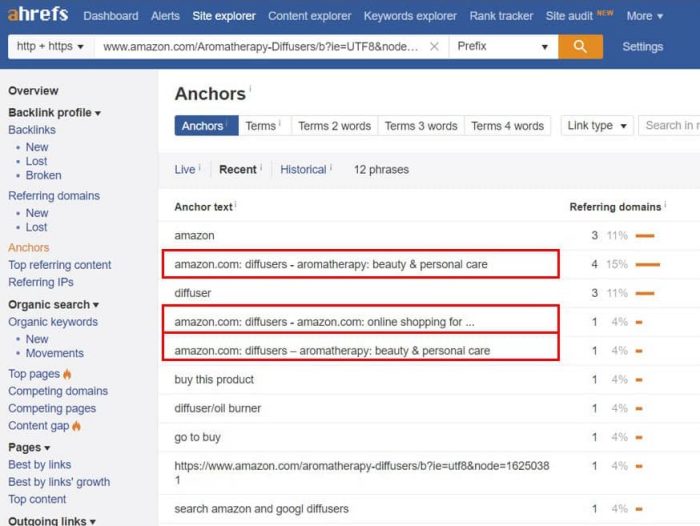
This is great for us, because it’s an easy way to sneak in more target anchors while reducing the risk of penalty, simply because they’re paired with branded/URL terms.
7. Optimize in relation to your URL
Over-optimization isn’t just a function of your niche-specific target anchor text distribution. It also depends on the URL that you’re linking to. If your URL has your keywords already in it, you’ll have less room to send an anchor with those same keywords.
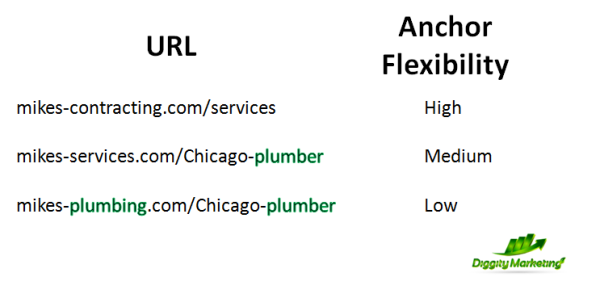
In example URL #1 above, the word plumber isn’t used at all, so you have the highest degree of freedom when it comes to sending anchors with the word “plumber”. URL #3 uses a variation of “plumber” twice, which really limits you in how many target anchors you can send to this URL. I would be extremely careful about over-optimization if you’re in the same boat as URL #3.
URL #2 is what most people are probably working with. In that case, stick to the niche-specific target anchor text and you should be fine. URL #2’s configuration is also what I recommend in my free Onsite SEO guide (found below).
8. Vary URL anchors
Always remember, when building your own links, the goal is to try to mimic the anchor text profile that would have been created naturally… as if you weren’t building your own links.
This is why you should create a diverse profile of various anchor categories as according to the niche average. Categories such as branded, URL, target, misc, topic, etc.
Amateur SEOs might do well at varying up their target anchors (as in trick #1) but will use the same exact anchor over-and-over when they’re creating URL anchors.
- https://www.website.com
- https://www.website.com
- https://www.website.com
- https://www.website.com
- https://www.website.com
But what are the **** that 100% of the people across the world that linked to you with URL anchors all sent exactly the same one?
Slim.
There are 64 variations (that I can think of) for URL anchors. Here’s a few.
- https://www.website.com (standard)
- https://www.website.com/ (backslash at the end)
- https://website.com (missing www)
- www.website.com (missing http)
- website.com (missing http and www)
Combo them together. Vary them up.
Another outside-the-box URL anchor is sending a homepage anchor to an inner page URL.
It’s pretty rare, but it happens.
Here’s one going to an inner page on Ahrefs.

9. Long Phrases
As SEO’s we often think, for lack of a better word… as SEOs.
- “I need a target anchor. So I’ll send this exact match anchor text.”
- “Time for a miscellaneous anchor? Ok, ‘click here’ it is.”
But always remember, anchors for contextual links (i.e.: in the body of the article) naturally are trying to describe what they’re linking to. Sometimes that can be done with one word, sometimes it takes 10.
Mix in some longer phrase anchor texts now and then.
Scroll up to the last link I created in this article for an example.
10. Write anchors in English, not SEO-ese
When people are trying to rank for local terms, such as “plumber chicago”, what they typically do is create backlinks with the anchor “plumber chicago”.
Yes, many local SEO tools will show that this type of keyword get the most searches, but how does this look in an article?
“Most families in the area prefer to visit Dr. John Smith, whom is the top-rated plumber chicago.”
Our number one job as SEO’s is to make it seem like we’re not doing our own SEO, and to make it appear that people are linking to our sites on their own accord. Now looking back at the example anchor, no natural website would ever link like this.
Instead, just use “plumber in Chicago”. You’re still getting credit for “plumber chicago”, but you look natural while doing it, which results in a better ranking boost.
Note: this isn’t based on just theory. This is based on actual test results.
11. Synonyms
 This handy trick is used to get credit for your keyword while avoiding over-optimization. Google has built-in an extensive amount of latent semantic indexing (LSI) and synonym matching into its algorithm. You see this on a daily basis but you might not notice it.
This handy trick is used to get credit for your keyword while avoiding over-optimization. Google has built-in an extensive amount of latent semantic indexing (LSI) and synonym matching into its algorithm. You see this on a daily basis but you might not notice it.
When you search for “how to sell automobile online” you’ll see that Google actually bolds the keywords that match your search terms. The word automobile has 4 synonyms (car, cars, auto, vehicle) that you can use instead. And this is just what’s shown on page 1.
When you’re reaching your limit on how many times you can use your target keywords, start to throw in synonyms instead. You’ll get the ranking boost while dodging Penguin over-optimization.
I do the same synonym replacement strategy when optimizing keyword density. You can read more about that here:
12. Surround anchor text with related keywords
It’s common industry assumption that if you surround your anchor text with adjacent keywords, longtails, and synonyms, that may help increase the relevance of that link.
For example, if your anchor text is “click here” then it really doesn’t provide any topical value.
But if you were to put it in a sentence like “To learn more about garcinia cambogia’s benefits, click here”, then the assumption is that the link will transfer more topical relevance.
I said “assumption” twice. Not because I don’t think its true, but just because I haven’t tested it myself, so I hesitate to stand by it.
The test is in the queue.
13. What if you’ve messed up?
Now that you have this information, you don’t necessarily need to go in and fix all your anchor text to be perfect. However, if you realized you’ve really screwed yourself, then I highly recommend that you don’t change your anchor text on existing links, but instead, delete links and replace them with new links using the anchor text that you want.
Remember, the name of the game is to look natural. What kind of business owner would have the ability to contact all the ‘web developers’ who naturally built links to his site? Only an SEO.
If you’re already ranking decently, don’t change a thing. Simply use these techniques going forward when you build links and get a ton of additional value out of them.
Anchor Text for Tiered Link Building

A lot of questions come up regarding what anchor text to choose when you’re building links to a tier.
What is tiered link building?
It’s when you have links going to your money site (tier 1), and then you link to these links with a tier 2. Or you might link to the tier 2 as well.
Historically, tiered link building came about when Google started penalizing people that were spamming backlinks with automated software directly to their money site.
So what did blackhat SEOs decide to do instead?
Create a tier of web2.0s with high authority, link them to their sites, and spam the web2.0s instead.
Some fancier examples of this are:
- Trust Pulling
- Trust Tiering
- PBN linking to guest posts
- etc

So what kind of anchor text should be used to send to tiers?
The Alternation Technique
These days I’m not doing much tiered link building except for the occasional powering up of guest posts with PBNs.
The following tactic was developed back in the day based on a lot of testing with tools like GSA and FCS.
I’ve had discussions with Colby Wren (master of spam when it was still working) and they do the same thing.
Quite simply:
- If your tier 1 link to your money site is a target anchor text, then link to it with a branded/URL/longtail mix.
- If your tier 1 link to your money site is a non-target anchor text, then link to it with target anchor text blend.
This applies down into tiers 2, 3, etc.
As you’ve noticed, each tier will alternate between aggressive and non-aggressive anchors.
Tiered link building, by definition, comes with its own risks. People who employ it as a practice are doing so because they’re masking spammy links with a tier of more trusted ones.
That said, aside from these risks, this anchor strategy is optimal from both a safety perspective and an effectiveness perspective.
Internal Anchor Text Optimization
So now that you’ve mastered the art of external anchor optimization, guess what, the show’s not over.
There are still rules for the links you send internally, from one page of your site to another.
Story Time
It was a cold evening on November 2, 2012.

Matthew Diggity, amateur SEO, is sitting in his office with grand schemes.
Black Friday is just around the corner and Matthew wants to take his “Best Ergonomic Chair” website to the stratosphere.
The Idea
Review every single ergonomic chair in existence, link them back to the ergonomic chair review homepage, increasing the topical relevance, and then rank #1 for ALL THE THINGS!
The Failure
Idiot-Matthew indeed reviewed every single ergonomic chair listed on Amazon. He created beautiful standalone pages for each of these. And he linked all of them back to the homepage with “best ergonomic chair”.
What happened to the rankings?
Tanked the day before Black Friday.
Balancing Internal Anchors
The above is, sadly, a true story.
Eventually, I figured out what I did wrong. I had assumed that internal anchor text for a website was a non-factor.
Once I adjusted the internal anchor text to be more balanced, rankings recovered… unfortunately after the holiday season.
This story sits with me as a harsh lesson to this day and is the reason why I’m so particular about getting internal anchor text ratios correct.
From page-to-page, anchor distributions do indeed need to be distributed, but they can be a lot more aggressive than external.
Here’s the distribution that I typically follow now:
Internal Anchor Distribution Recommendation
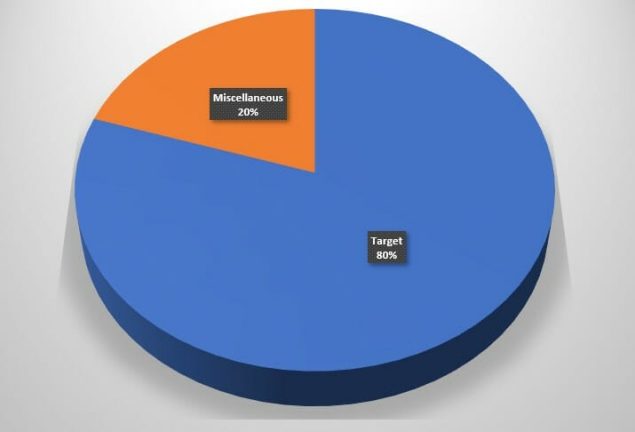
Based on recent tests, this distribution is indeed on the conservative side. I’ve gotten away with a lot worse.
That said, it will keep you safe.
Internal and external anchor ratios do indeed interact together, so if you mistakenly over-optimize externally, this conservative internal ratio will give you some padding.
FAQ
What is Anchor Text Optimization?
Anchor text optimization is the crafting of both internal and external anchors, with the goal of increasing search engine rankings.
What is rich anchor text?
Rich anchor text also known as Keyword Rich Anchor text, refers to any anchor text that has a portion of the intended keyword you would like to rank for. For example, if you’re trying to rank for “best protein powder”, the anchor text “recommended protein powder” would be a rich anchor text.
Are anchor links good for SEO?
Yes, anchor links are good for SEO. The anchor text of a backlink is useful for telling the search engines what it is that they’re linking to. This helps to establish relevance, which is a ranking factor.
What is an empty anchor?
An empty anchor text occurs when a link is created from an image and no alt tag is specified.
When should I use nofollow links?
You should use nofollow links as a signal to Google that you do not want this link to count towards the target website’s backlink profile. There are certain circumstances in which Google has advised that you use nofollow links, such as links for advertisements.
Conclusion
Thanks for taking a nerdy walk with me down Anchor Text Lane.
I hope you’ve become aware of the importance of Anchor Text Optimization.
Let’s sum up what you’ve learned:
You’ve learned how to find the niche-specific target anchor text that your page needs.
You’ve learned how to make individual anchor text decisions that are going to set you apart from your competition by looking more natural, while still being effective.
You’ve learned how to balance internal anchor text.
If this has helped you or if you have any questions, please leave so in the comments below.


